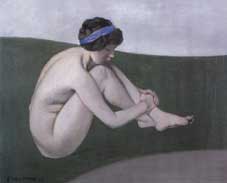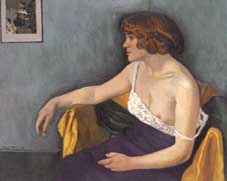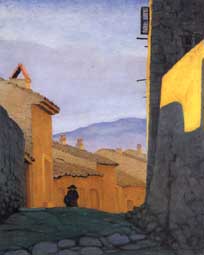Born in Lausanne in 1865, Félix Vallotton was issued from an old Protestant family which had settled in Vallorbe, near the French border in the Jura mountainous region. 
"Nu au ruban bleu", 1912
His grand-father had been head of the penitentiary of Lausanne from 1849 while his father ran a drugstore in that city. At 17, Félix decided to become a painter and came to Paris where he experienced some difficulties, meeting the opposition of his family. He first worked as a restorer and an engraver to eke out a living and studied frantically to improve his style.
He also wrote theatre plays and novels before meeting some painters of the French Nabi movement, notably Vuillard, who encouraged him much. Félix nevertheless worked intensely in order to reach success, producing some 1587 paintings and engravings during his lifetime.
Vallotton showed much patience in his early paintings working with an acute eye and a deepe sense of research like Maurice Denis, Vuillard or Bonnard.

"Jeune femme", 1914
He also found some influence in Japanese art, notably prints, while producing woodcuts, lithographs and etchings choosing his themes in street and cabaret scenes and instilling much humour in his works. His talent as a caricaturist notably led him to deliver many prints for several satirical newspapers which helped him earn a decent living. Such prints, which drove him to simplify forms to a maximum, resulted in the adoption of a more explicit language and a much sober touch in his paintings. Throughout his career Vallotton strove with much fervour to impose much significance and a sense of research in his works, notably in sevreal series of nudes and landscapes.

"Une rue à Cannes", 1922
During the last part of his career Vallotton, who had taken up French nationality in 1900, gave up open air painting and worked in his studio instead. He also flirted with abstraction and juggled with light with much spirit though his works appeared finally much austere and cold.
Vallotton much admired Leonardo da Vinci, Raphael, Holbein, Poussin and Ingres but never worked under their influence. However he appeared much inspired by Manet regarding the choice of his themes but overall he stayed aloof from the Nabi movement following his own path instead.